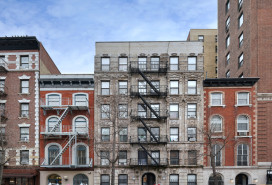Rent-stabilized tenants are leaving these neighborhoods in droves. Here's what to do if you're pressured to move
Landing a rent-stabilized apartment can be a major coup. You're protected from the ever-escalating rent increases that bedevil tenants in market-rate units, and it looks likely that the Rent Guidelines Board will institute a rent freeze for the third year running, reports the New York Post, meaning that rent-stabilized tenants can renew their leases for another year with no increase to their monthly payments at all.
Finding such an apartment can be a challenge, and holding onto one, possibly even more so. WNYC writes that some neighborhoods are seeing a rapid turnover of their rent-stabilized units, with tenants departing and more apartments becoming market-rate.
Astoria, Bay Ridge, and Morningside Heights all have particularly high turnover rates, which could be due to tenants moving elsewhere of their own volition. But another possibility is that landlords are trying to get stabilized tenants out so they can deregulate the units and earn significantly more income on them.
Once the monthly rent on a stabilized apartment hits $2,700 and its tenant moves out, landlords can then rent them at the market rate. Evan Hess of the Northern Manhattan Improvement Corporation explains to WNYC that rents are already relatively high and increasing in these three neighborhoods, which means stabilized units may be hitting that ceiling of $2,700 faster than they do in other areas of the city.
It's important to note, though, that even when the rent surpasses $2,700, apartments remain stabilized until the tenant leaves. To that end, some unscrupulous landlords do use shady means to get renters out; last year, for instance, it was discovered that 50,000 units across the city had been illegally deregulated.
How landlords force out tenants
Landlords have deployed a number of tactics to force out stabilized tenants. Brick previously reported on how Steve Croman, who owns 140 buildings in Manhattan, pressured stabilized tenants into moving out by using ex-NYPD officers to bully them, doing construction that made their apartments unlivable, and refusing to cash rent checks, then taking renters to court for non-payment.
We also wrote about how rent-stabilized tenants in buildings owned by Jared Kushner have alleged harassment, with their building's management undertaking renovations that led to dust, damage, and noise in order to coerce them to move out.
And sometimes, landlords simply fail to inform renters that they're living in a rent-stabilized building, and illegally overcharge them. RentLogic estimates that as many as 200,000 apartments in New York should be stabilized, but aren't listed as such.
What you can do as a rent-stabilized tenant
If you think your aparment might be stabilized, you can confirm at sites like Am I Rent Stabilized? or the city's list of stabilized buildings. (A good rule of thumb is that properties built before 1974 that contain six or more apartments are typically stabilized.)
And if you suspect your landlord is using underhanded tactics, like "renovations" or other forms of harassment, in order to make life so miserable you have no choice but to leave, your best recourse may be to find strength in numbers. Renters in several East Village tenement buildings owned by Raphael Toledano banded together in protest of what they say was harassment designed to get them out.
Tenants' rights attorney Sam Himmelstein (fyi, a Brick sponsor), confirms that forming a tenant association will make you much stronger politically and financially when you're facing pressure to leave your home; the Met Council on Housing has resources on how to get started here.
You Might Also Like


























